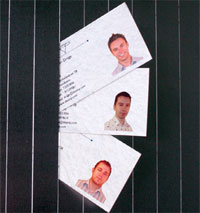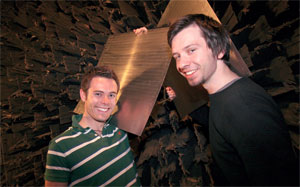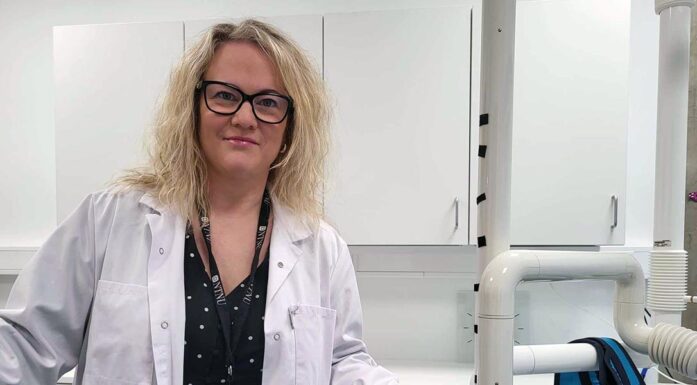Absorbing sound with hard materials
Sound-absorbing metal plates seem impossible – but they are not.
Architects will love them. People with allergies will find it easier to breathe. All of this because of an acoustic improbability: Sound-absorbing plates that don’t contain the fibres that cause allergy and asthma, and that can also be used as aesthetic interior design elements.
PRACTICALLY NO HOLES
Most sound-absorbing plates are made of porous materials. De- Amp, a new Norwegian company founded by engineers from NTNU, has taken the opposite approach, using hard materials such as metal, plastics, glass and Plexiglas to muffle sound. The secret lies in very fine micro fissures that have been burnt right through the plates using a laser, combined with the design of the spacing between the fissures. The metal plates are less than one millimetre thick and are intended for indoor use, in ceilings or walls. The plates have to have a space of a few centimetres behind them to muffle the echo of bass and mid-range sounds, which are in the pitch of the human voice.
Common, perforated sound-absorbing plates, known as cavity absorbents, have a perforation rate of 10 to 30 per cent. The new, hard plates have a perforation rate of less than 1 per cent.
“They appear unbroken, and can be used creatively, as signs, or even as part of a piece of art, because they can be shaped”, says Bjørn André Fløtre, product developer for DeAmp.
“The plates can also be wave-shaped, as long as the cavity behind them has the exact same shape. That makes them even more efficient as the absorbing surface gets even larger. The sound-absorbing effect results when sound waves hit the plate and cause the air in the fissures to vibrate. Energy is lost because of the friction between the air and the walls of the fissures, and the friction drains the sound of energy and absorbs it as heat.”
HEALTH BENEFITS
Microscopic fibres that escape from sound-absorbing materials are a problem for people with respiratory problems. The Norwegian Board of Health’s standards for indoor air quality state that “Exact levels for the prevention of health effects are not yet known, but free fibres in indoor air should not be permitted”. Nevertheless, schools and offices often contain sound-absorbing materials that produce fibres as they degrade. Thus, the sound-absorbing, fibre-free plates could offer major health benefits. The plates are also quite easy to clean, because they can be both washed and flushed with water or other cleaners.
ORIGINATED AT NTNU/SINTEF

MICRO FISSURES: DeAmp’s new, sound-absorbing plates have continuous, laser-cut micro fissures measuring 0.2 millimetres. The fissures are cut in such a way that less than 1 per cent of the plate is actually perforated.
Photo: Nina Tveter
The idea behind this product originated in the acoustic research laboratories at NTNU and SINTEF. The use of micro-perforation with holes as a technique for sound reduction is a well-known technology, but over the last several years, Professor Emeritus Tor Erik Vigran has developed this technology even further. He has developed a program that can calculate the design criteria for sound absorbents and has crafted a special version of the program that is used to make sound-absorbing plates.
Professor Vigran and Odd Kr. Ø. Pettersen, NTNU professor and Head of Research at SINTEF IKT, started this work as a result of student projects in the autumn of 2003. The results were so promising that Bjørn André Fløtre and two other advanced engineers from NTNU, Pål Ove Henden and Ole-Christian Drage, established DeAmp as a company and applied for a patent for the technology, with the goal of commercialising the idea.
FOR PUBLIC PLACES
Currently, the firm is trying to find partners that can manufacture the plates at a large scale and for a reasonable price. Several European companies in Germany, Italy and Slovakia are being considered. A prototype will be ready this autumn, with the goal of having the plates on the market in the spring.
So far, DeAmp has focused on aluminium and steel as the materials of choice for their plates. The firm’s main market will be businesses that have public spaces.
“Restaurants, conference rooms, offices and hotels, places with special requirements for finish and decoration, are target groups for us”, says Fløtre. “In the future, plates made of plastics could be of interest in surgical settings, or in the food industry where hygiene requirements are very strict. Several types of plastic have been approved for medical use because they can be sterilized”.
By Nina Tveter





